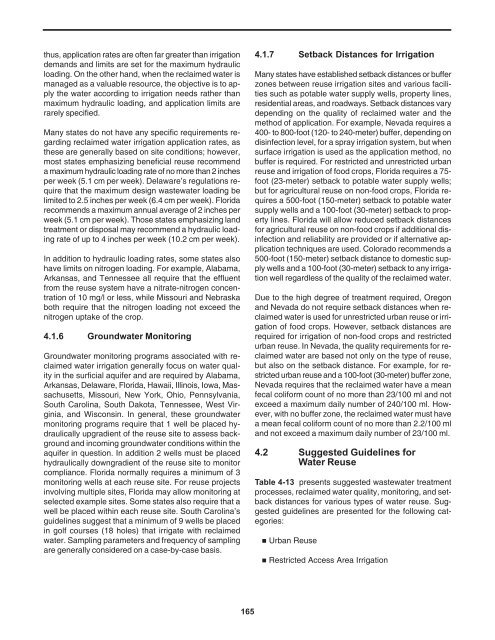o_19f3m1n7k170b14e9u0oqipgu4a.pdf
You also want an ePaper? Increase the reach of your titles
YUMPU automatically turns print PDFs into web optimized ePapers that Google loves.
thus, application rates are often far greater than irrigation<br />
demands and limits are set for the maximum hydraulic<br />
loading. On the other hand, when the reclaimed water is<br />
managed as a valuable resource, the objective is to apply<br />
the water according to irrigation needs rather than<br />
maximum hydraulic loading, and application limits are<br />
rarely specified.<br />
Many states do not have any specific requirements regarding<br />
reclaimed water irrigation application rates, as<br />
these are generally based on site conditions; however,<br />
most states emphasizing beneficial reuse recommend<br />
a maximum hydraulic loading rate of no more than 2 inches<br />
per week (5.1 cm per week). Delaware’s regulations require<br />
that the maximum design wastewater loading be<br />
limited to 2.5 inches per week (6.4 cm per week). Florida<br />
recommends a maximum annual average of 2 inches per<br />
week (5.1 cm per week). Those states emphasizing land<br />
treatment or disposal may recommend a hydraulic loading<br />
rate of up to 4 inches per week (10.2 cm per week).<br />
In addition to hydraulic loading rates, some states also<br />
have limits on nitrogen loading. For example, Alabama,<br />
Arkansas, and Tennessee all require that the effluent<br />
from the reuse system have a nitrate-nitrogen concentration<br />
of 10 mg/l or less, while Missouri and Nebraska<br />
both require that the nitrogen loading not exceed the<br />
nitrogen uptake of the crop.<br />
4.1.6 Groundwater Monitoring<br />
Groundwater monitoring programs associated with reclaimed<br />
water irrigation generally focus on water quality<br />
in the surficial aquifer and are required by Alabama,<br />
Arkansas, Delaware, Florida, Hawaii, Illinois, Iowa, Massachusetts,<br />
Missouri, New York, Ohio, Pennsylvania,<br />
South Carolina, South Dakota, Tennessee, West Virginia,<br />
and Wisconsin. In general, these groundwater<br />
monitoring programs require that 1 well be placed hydraulically<br />
upgradient of the reuse site to assess background<br />
and incoming groundwater conditions within the<br />
aquifer in question. In addition 2 wells must be placed<br />
hydraulically downgradient of the reuse site to monitor<br />
compliance. Florida normally requires a minimum of 3<br />
monitoring wells at each reuse site. For reuse projects<br />
involving multiple sites, Florida may allow monitoring at<br />
selected example sites. Some states also require that a<br />
well be placed within each reuse site. South Carolina’s<br />
guidelines suggest that a minimum of 9 wells be placed<br />
in golf courses (18 holes) that irrigate with reclaimed<br />
water. Sampling parameters and frequency of sampling<br />
are generally considered on a case-by-case basis.<br />
4.1.7 Setback Distances for Irrigation<br />
Many states have established setback distances or buffer<br />
zones between reuse irrigation sites and various facilities<br />
such as potable water supply wells, property lines,<br />
residential areas, and roadways. Setback distances vary<br />
depending on the quality of reclaimed water and the<br />
method of application. For example, Nevada requires a<br />
400- to 800-foot (120- to 240-meter) buffer, depending on<br />
disinfection level, for a spray irrigation system, but when<br />
surface irrigation is used as the application method, no<br />
buffer is required. For restricted and unrestricted urban<br />
reuse and irrigation of food crops, Florida requires a 75<br />
foot (23-meter) setback to potable water supply wells;<br />
but for agricultural reuse on non-food crops, Florida requires<br />
a 500-foot (150-meter) setback to potable water<br />
supply wells and a 100-foot (30-meter) setback to property<br />
lines. Florida will allow reduced setback distances<br />
for agricultural reuse on non-food crops if additional disinfection<br />
and reliability are provided or if alternative application<br />
techniques are used. Colorado recommends a<br />
500-foot (150-meter) setback distance to domestic supply<br />
wells and a 100-foot (30-meter) setback to any irrigation<br />
well regardless of the quality of the reclaimed water.<br />
Due to the high degree of treatment required, Oregon<br />
and Nevada do not require setback distances when reclaimed<br />
water is used for unrestricted urban reuse or irrigation<br />
of food crops. However, setback distances are<br />
required for irrigation of non-food crops and restricted<br />
urban reuse. In Nevada, the quality requirements for reclaimed<br />
water are based not only on the type of reuse,<br />
but also on the setback distance. For example, for restricted<br />
urban reuse and a 100-foot (30-meter) buffer zone,<br />
Nevada requires that the reclaimed water have a mean<br />
fecal coliform count of no more than 23/100 ml and not<br />
exceed a maximum daily number of 240/100 ml. However,<br />
with no buffer zone, the reclaimed water must have<br />
a mean fecal coliform count of no more than 2.2/100 ml<br />
and not exceed a maximum daily number of 23/100 ml.<br />
4.2 Suggested Guidelines for<br />
Water Reuse<br />
Table 4-13 presents suggested wastewater treatment<br />
processes, reclaimed water quality, monitoring, and setback<br />
distances for various types of water reuse. Suggested<br />
guidelines are presented for the following categories:<br />
• Urban Reuse<br />
• Restricted Access Area Irrigation<br />
165



